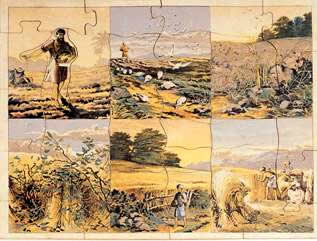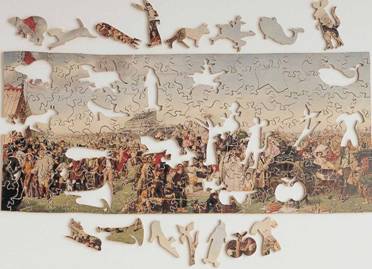History of Jigsaw Puzzles
Historical discoveries are coming along all the time but here, as best we can make out, is the story so far.
1760 (Approximately)
The first jigsaw was made. John Spilsbury (an Englishman) mounted a map of England on a thin sheet of mahogany board, used a hand held fretsaw to cut round the county boundaries and sold the boxed pieces for children to assemble. They were known as ‘Dissected maps’. During the next 40 years several other manufacturers (including individuals in Holland) copied John Spilsbury’s ideas and introduced historical scenes to complement map subjects.
Nineteenth Century
In the early part of the century, puzzles were made almost exclusively for wealthy children and almost always with education in mind. To save on cutting labour the puzzles consisted of only a few large pieces and only the outside interlocked, the rest being cut quickly with straight or wavy lines. The wood used was usually Mahogany or Cedar.

The jigsaw named ‘The Parable of the Sower’ on the right was cut by Betts in about 1870 and typifies the style of jigsaws up to that date. Only the outside pieces interlock and the quality of the print is very poor by modern standards.
Towards the end of the century great strides were made in many manufacturing techniques and three of these influenced jigsaws:
- Treadle operated jigsaws were invented.
- Techniques were developed to produce THIN sheets of wood.
- Printing improved in leaps and bounds.
These technological advances enabled jigsaws to be made that were much more intricate, durable and colorful. Adults became interested in doing jigsaws and this spurred the manufacturers to widen the range of subjects available and to make them more difficult to do. It became evident that colorful, complex jigsaws held a fascination for many people.
In the late 1800’s a German furniture dealer named Raphael Tuck and his two sons developed 4 techniques that set the scene for jigsaw development into the next century:
- Their subjects included many varied and colorful topics.
- Cutting was made more intricate and included ‘Whimsies’ – individual pieces cut into recognisable shapes like animals and household goods.
- Plywood and thick card started to be used instead of expensive hardwood.
- Attractive boxes (that for the first time included an image of the uncut puzzle) were introduced.
Those with an interest in history might like to know that Raphael Tuck was also instrumental in the development of other industries – he is credited with the first commercial production of Christmas cards and also the first picture postcards. He set up printing establishments in London, Paris and New York and in 1893 he received the Royal Warrant from Queen Victoria for printing the Queen’s letter to the nation on the occasion of the death of the Duke of Clarence.
Twentieth Century
The ideas of Raphael Tuck and his family were adopted in America and by 1908 a full-blown craze was underway there. Likewise in England, the rich embraced jigsaws to the extent that they became THE pastime amongst the well-to-do.
The First World War (1914 -1918) temporarily curtailed activities but things soon picked up again afterwards. By 1929 the Americans were buying two million jigsaws a week and every self-respecting English dinner or tea party demanded a jigsaw or two!
To meet the booming demand, and to save on costs, enterprising jigsaw manufacturers like Chad Valley and G.H. Haytor (Victory puzzles) developed the technique of ‘Stack cutting’. This involved up to 8 jigsaws laid on top of each other, fastened together and all cut simultaneously. Nonetheless, cutting jigsaws was still time consuming and therefore expensive.

The Tuck puzzle to the left was made in about 1930. Compare the intricacy of the cut with that of the Parable of the Sower (above) that was cut 60 years earlier. The Tuck family continued to experiment with new techniques throughout their lives and it is they who did most to ensure the enduring popularity of jigsaw puzzles.
In the 1920’s an American company developed a technique for die cutting cardboard jigsaws that reduced production costs to a tiny fraction of the cost of cutting by hand. Waddingtons bought this know how in 1933 and the process revolutionized the popular perception of jigsaw puzzles. Now puzzles containing up to 1,000 intricately cut pieces became readily available at a price that everyone could afford. However, it took until the 1950’s for production techniques to be improved to the extent that cardboard puzzles could be termed ‘Good quality’. The technique for cutting these puzzles has not changed substantially since.
What has changed is the quality of printing, with the large jigsaw companies like Jumbo and Ravensburger now using superb quality images. Whether your preference is for art reproductions, photographs, sparkling special effects, or even ‘Glow in the dark’ you will find quality jigsaws that you will be delighted to make.
What of the Future?
In the world of cardboard jigsaws there is little that can be done to improve the cut or quality of the puzzles – the production techniques are nearly perfect. Innovative manufacturers have constantly found new images to charm, thrill, baffle and bemuse us and there is no reason to suspect that this will ever end.
Wooden puzzles are generally more durable than cardboard puzzles and are often the preferred choice for investments. The question is how to manufacture wooden puzzles at an affordable price? Technology may provide the answer in the form of controlled lasers and water jets for automated cutting. These amazing devices might just give wooden puzzles a sporting chance of success in the twenty first century.
With sincere thanks to Mr Tom Tyler – probably the most knowledgeable, and certainly the most enthusiastic jigsaw-puzzler that we have ever known.